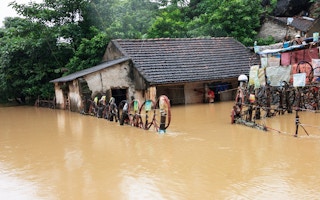It is clear that the long-term solution to climate change lies in weaning the global economy off fossil fuels and onto a cleaner and more sustainable energy pathway in every country. But it is also clear that climate change is already wreaking havoc around the globe and that, in the short term, the world’s poorest and most vulnerable people need urgent support.
To continue reading, subscribe to Eco‑Business.
There's something for everyone. We offer a range of subscription plans.
- Access our stories and receive our Insights Weekly newsletter with the free EB Member plan.
- Unlock unlimited access to our content and archive with EB Circle.
- Publish your content with EB Premium.
All of this will require a great deal of money. The good news is that this is a price we can afford to pay. As this week’s report by the Global Commission on the Economy and Climate shows, spending money to tackle climate change will drive economic growth, creating jobs and prosperity.
As our leaders begin to rise to the challenge and decide how to allocate finances, it is critical that they understand that climate change is a two-part problem, and this means there two sides to every climate change coin.
Mitigation money
First, there is the cost of limiting climate change by reducing the amount of carbon in the atmosphere – or ‘mitigation’ in the climate jargon. While this will not be cheap, it may not require only new money.
Trillions of dollars are already available to invest in energy, communications and urban infrastructure. It is essential to spend these funds on cleaner energy and more resilient infrastructure instead of in business-as-usual investments that will extract and burn more coal, oil and gas.
Indeed, we need to divest from the fossil fuel companies to keep carbon underground.
Invest to protect
“
Spending money to tackle climate change will drive economic growth, creating jobs and prosperity.
At the same time, we must deal within the unavoidable impacts of climate change. These are becoming evident across the globe, from the drought in California to the floods in Kashmir. This is where the other side of climate finance comes in. Because while climate change will affect all countries, even the rich ones, it is hitting the poorest countries and poorest people in all countries first.
They urgently need to adapt and this too will cost money. And while the rich countries have promised to provide poorer developing nations with US$50 billion a year from 2020 to help them adapt, there is no such promise of any financial support before then.
A balancing act
Against this backdrop of short and longer term needs, in April this year delegates at the 8th International Conference on Community Based Adaptation to Climate Change adopted the Kathmandu Declaration on climate finance. It makes three key demands:
- All global funding for climate change should be split equally between mitigation and adaptation. At the moment 90 per cent goes to mitigation
- Half of any international finance for adaptation should be allocated toward the most vulnerable communities. This should also be a reporting requirement for all funders of adaptation. In a positive move, the Green Climate Fund‘s board has decided to allocate half of its funds to adaptation and to focus that spending on the most vulnerable developing countries, and
- At the national level, half of all funding for adaptation should be allocated to the most vulnerable communities. In this regard I would note the example of Nepal, which has decided to allocate 80 per cent of its climate change funds to the local level, to support the country’s pioneering Local Adaptation Plans of Action.
A turning tide
Politicians, business leaders, economists and people from all walks of life increasingly accept what scientists have been saying for years – that climate change is perhaps the most important challenge facing humanity.
On 21 September, the people’s climate march in New York and similar events around the world will help to cement this message in the minds of millions of people. Two days later, at the UN Secretary-General’s Climate Summit, heads of government will make pledges of action to tackle climate change. I will be in New York for both events and will promote the Kathmandu Declaration at every opportunity.
Despite all of the momentum, we must remember the scale of the challenge. All that has been do so far to address climate change has been inadequate.
Our chances of limiting the global average temperature increase to 2°C above pre-industrial levels diminish day by day. And while that makes mitigation ever more urgent, it also drives home the need to invest in adaptation without delay.
Saleemul Huq is a senior fellow of IIED. This post originally appeared on the IIED blog.











